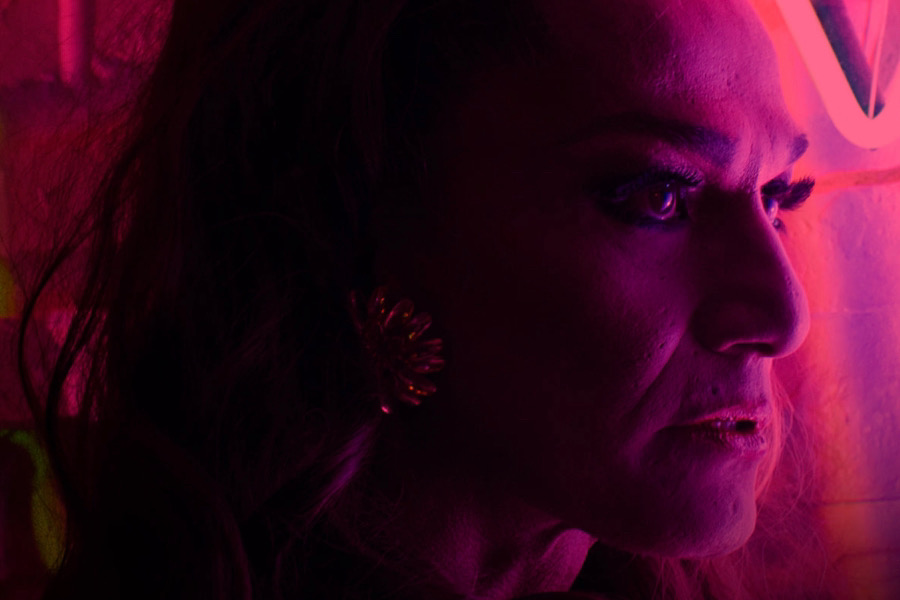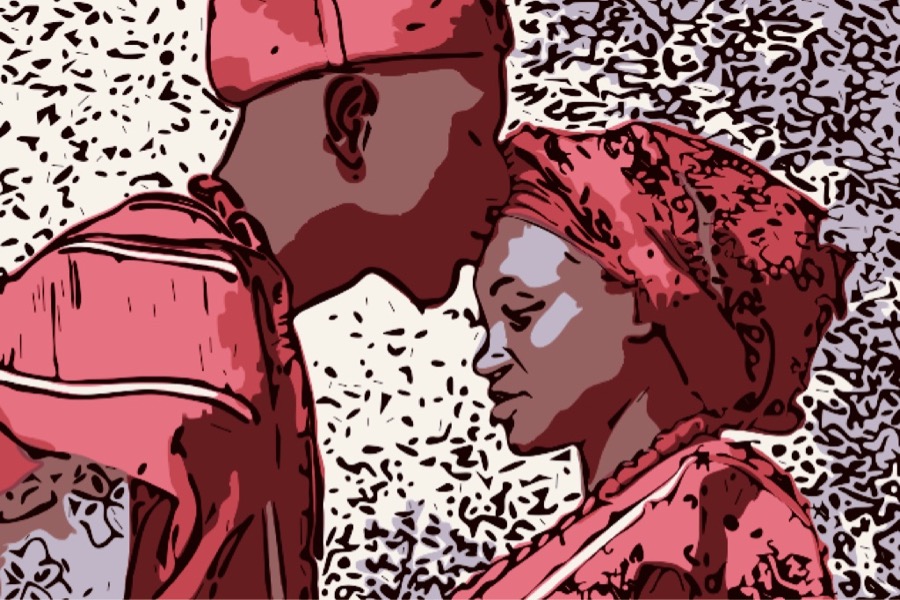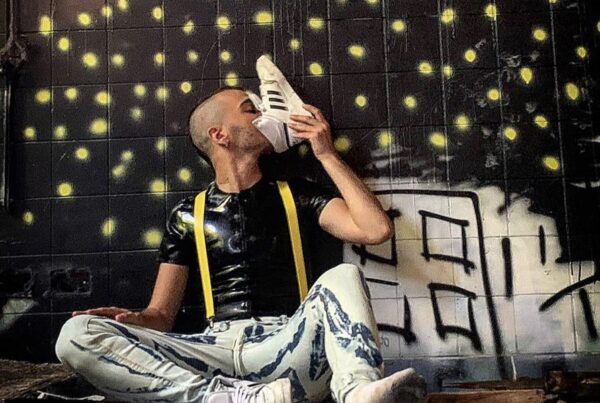“Transforming from a man to a woman and looking perfect; that is
artistic. A man who puts on three pairs of eyelashes on his eyes, and
puts on breasts; that is artistic”
Jairo Polo“Wearing high heels: that is the symbol of the drag artist! Having good high
heels and well-made-up lips”
Shorell (Darwin Villa)“Now I am the person who is here in front of you … I apply makeup on myself and start to erase those strong male facial features that I have. I’m looking at myself, and the mirror is my friend.”
Thael Osorio de la Rans
The she-wolf is considered in many cultures as the initiator of a new process or civilization; the symbol of strength in battle, intelligence, transgression of prohibitions, and freedom; the queen of loving passion and sociability. In the mid-80s, an Argentinian singer, Valeria Lynch, let all these characteristics shine in her voice of a creature wounded by life experiences and a love that was ending.
Those were the years when nightclubs were full of people willing to listen to the new hits from Madonna and Michael Jackson or the great divas of the time, heroines of the ironing songs. But it was also the moment of the massive diffusion of AIDS, and young and painful deaths, and at the same time of the fights for the affirmation of LGBTQIA+ rights, of which transsexuals, transgender people, crossdressers, and drag queens were the absolute protagonists.
In that convulsive and at the same time extremely vital context, the first parades of the LGBTQIA+ community from Barranquilla, that gathered around the famous nightclub Troya In Bar, took place. In the beginning, the route used to be very short and often tarnished by physical attacks and insults targeted at the participants. Some important personalities of the collective developed, therefore, their artistic proposal in a homo/transphobic general climate: Gustavo Turizo, La Nordika, Rosa Paulina, Camélica Stephania Noreña, and Alfonso Suárez Ciodaro exercised all their resilience and talent in works that will influence several generations of artists and performers.
 The documentary
The documentary
The documentary “Como una Loba” (Like a she-wolf), directed and produced by Danny González Cueto, with the collaboration of Colectivo Transmallo, Semillero Cuerpas, and the Feliza Bursztyn Research Group from the Atlantic University in Barranquilla, wants to pay tribute to that fight and those personalities who have left an indelible mark in the history of the art of drag at local and national levels.
As a result of a rigorous source collection work and original formal experimentation of the images, the audiovisual proposal traces the history and present of the drag phenomenon related to the Barranquilla Carnival through their most representative voices.
In its 34 minutes of running time, a series of audiovisual records alternate from the biennium 2016/2017 until the most imminently recent years to constitute a vibrant archive of testimonials, points of view, and ideas in the experimental framework of the images that introduce and close the interviews.
By the reconstructions of Eusebio Castro, Jairo Polo, and Heriberto Mejía the public approaches the genesis of the first attempts to extricate a cultural and artistic heritage that until the early 80s was the prerogative of the gay nightclubs, with their contests to elect the queen during the pre-carnival season and their impressive shows; to attend them, Polo confirms, the public was willing to pay exorbitant prices. When it was presumed that this precious cultural baggage could be lost, they wanted to take the step of taking it out to be recognized by a society that at the time was very closed to sexual diversity and driven by strong religious prejudices.
Wilson Castañeda, president of the NGO Caribe Afirmativo, highlights the importance of the gay guacherna at the national level, as a precursor event of the pride parades from Bogotá and Medellín, dating back to 1990/1991: seven years after the experience from Barranquilla.

A sinistra: Camélica
Julieth Pantoja, who at that time shocked the audience with a memorable performance of the famous song by Valeria Lynch which re-proposes here for the documentary, dues the beginning of her career to a renowned contest “El Baco de Oro”, which took place in a very crowded nightclub.
Victor Ladrón De Guevara Yepes, who personifies her, also offers us a clear distinction between crossdressing and drag; in his opinion, it has to do with luxury without being expensive, vanity, good taste, and the search for the aesthetically beautiful. The survival of this practice will depend, according to the performer, on the media management that is made of it.
In the boy who wears his sister’s clothes, who fills his breasts with pieces of bread, and who has money just to buy a synthetic wig there is, according to the writer Jhon Better, much more than a simple transgression. What is manifested in that case is a powerful act of imagination. Those who practice it in a marginal context, the author reflects, are people who have embarked on a fight against the current. As Thael de la Rans recalls: “It is very difficult for the people to accept you because there will always be bullying, homophobia; but after you accept yourself, you will be a great drag queen.”
Gloria Ivon (Álvaro Gómez) went through the same personal process before becoming the icon she is. This is how the vedette expresses herself: “I did not pretend to wear hormones in the body, but hormones in the mind.” With these words, the artist introduces the concept of transsexual-mental, emphasizing the performative use of the body without going through medicalization. From this point of view, her work as a theatrical drag queen becomes the “appendage of her personal unfoldment.”

Gloria Ivón
Camélica, remembered by Shorell, is another one of those “great underground divas” (Hemel Noreña) who entertained Barranquilla’s nights with their “spark, their power of persuasion and their ability to involve people.” Probably, Noreña was referring to artists like Camélica when he spoke about shows that “because of their majesty made people with fears change their concept.”
The poet Benjamin Méndez is undoubtedly one of the greatest chroniclers of those fascinating years, in which you could admire “beautiful women, overproduced for the era; and worthy to be on Milan, New York or Rome catwalks.” Supreme Ambassadors of that “magic” that all gays have according to Jairo Polo, who adds that drag practices are “sarcastically an evolution which that being has at that moment who wants to represent a woman.”
If drag art allows a certain freedom and a full and satisfactory artistic expression of the performer, we must not ignore, according to Darwin Villa, that “we are the sore“. In other words, we are the ones who, from our bodies, wage a battle against discrimination and heteropatriarchal dominance.
“Como una Loba” intends to go beyond the memorialist or commemorative proposal and opens a dialogue towards aesthetics and drag experiences to recognize their centrality within performative art and the impressive political charge that characterizes them.
 The exhibition
The exhibition
The documentary is part of a much larger project entitled “Travestiario Tropical: representation and archives of the LGBTQIA+ body practices in the Barranquilla Carnival” which includes the exhibition that opened its doors on Thursday, November 4, and will be open until April 4, 2022, in the rooms of the Museum of Anthropology of the Faculty of Fine Arts of the Atlantic University.
The “Sexposition”, as the event is called, contains almost five hundred pieces, some of which are exhibited for the first time, belonging to the archives of various organizations or private collections, and divided into three sections: Locas de felicidad (from the title of the fortunate book by the Barranquilla writer Jhon Better), Theatricality, and Transit. The thematic itinerary, which reconstructs the Caribbean city’s underground scene from the 70s to the present, is enriched with films, texts by artists and activists, performance, and plastic works with which the public can interact during the visit.
The project includes the publication of a catalog that, in addition to containing a large part of the exhibited material, has a foreword by one of the pioneers of LGBTQIA+ activism in Colombia, Manuel Velandia, and an introductory essay that analyzes the history and academic debates about the topics covered in the exhibition and the documentary. The work team is composed of the artistic director Hanner Sánchez (aka Hanoi Utumayo), Juan Carlos Dávila as museography consultant, Rebeca Rocha Villamizar and Yuris Polo as archive managers. The research was entrusted to Danny González Cueto, who is also the exhibition curator and project director, and me.
Two young artists from Barranquilla, Rubén Barrios (aka LaRubiFag) and Lea Leandro, in addition to having curated the graphics for the catalog and the posters, each presented their work. LaRubiFag proposes “Transbestial X-rays”, a work that brings together photographic self-portraits and shots of queer people, homoerotic magazine clippings, black and white photocopies, and serigraphs. It is a heterogeneous and personal file of more than 180 pieces that will enrich the experience of the public.
Instead, Lea proposes a tribute to Lino Fernando, beauty stylist and prominent figure of the local LGBTQIA+ community until his violent death in 2007. The artistic proposal focuses on the tools of a beauty salon, which represent metaphorically Lino’s personality and connect perfectly with the imagery of the artist who “stages” them, thus creating an intergenerational bridge within the community and revealing all the topicality of Fernando’s aesthetics.
“Travestiario Tropical” is a journey through time and in a space far away from the European context that is worthy to approach.
Massi Carta
translation by Alberto Campo (Colectivo Transmallo)
©2021 Il Grande Colibrì
immagini: Travestiario tropical




